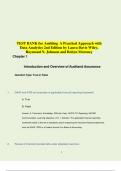TEST BANK for Auditing A Practical Approach with
Data Analytics 2nd Edition by Laura Davis Wiley,
Raymond N. Johnson and Robyn Moroney
Chapter 1
Introduction and Overview of Auditand Assurance
Question Type: True or False
1. GAAP and IFRS are examples of applicable financial reporting framework.
A. True
B. False
Answer: A, Taxonomy: Knowledge, Difficulty: Easy, AICPA FC: Reporting, AACSB:
Communication, Learning Objective: LO1.1, Solution: The applicable financial reporting
framework refers to the set of standards used in preparing the historical financial statements,
such as GAAP, IFRS or a Federal Income Tax Basis of Accounting.
2. Review of financial forecasts falls under attestation services.
1
, A. True
B. False
Answer: A, Taxonomy: Knowledge, Difficulty: Easy, AICPA FC: Measurement Analysis and
Interpretation, AACSB: Ethics, Learning Objective: LO1.1, Solution: Attestation services (under
the umbrella of assurance services) include review of historical financial statements, review of
financial forecasts, and examination of internal control.
3. Within a U.S. context, the applicable financial reporting framework is typically Generally
Accepted Accounting Principles (GAAP).
A. True
B. False
Answer: A, Taxonomy: Knowledge, Difficulty: Easy, AICPA FC: Measurement Analysis and
Interpretation, AACSB: Ethics, Learning Objective: LO1.2, Solution: Within a U.S. context, the
applicable financial reporting framework is typically generally accepted accounting principles
(GAAP).
4. Private companies, or non-issuers, are not required by the U.S. government to have an
annual financial statement audit
A. True
B. False
Answer: A, Taxonomy: Knowledge, Difficulty: Easy, AICPA FC: Reporting, AACSB: Analytic,
Learning Objective: LO1.2, Solution: Private companies, or non-issuers, are not required by the
U.S. government to have an annual financial statement audit, but often other interested users,
2
, such as a bank or lender, may request that a private company provide audited financial
statements.
5. One of the reasons there is a demand for financial statement audits is that users of
financial statements often lack accounting and legal knowledge to fully understand
complex accounting and disclosure choices.
A. True
B. False
Answer: A, Taxonomy: Comprehension, Difficulty: Easy, AICPA PC: Communication, AACSB:
Analytic, Learning Objective: LO1.3, Solution: Complexity: Financial statements are complex, the
amounts are often affected by significant estimates, and the disclosures often require significant
knowledge and experience to evaluate. Most financial statement users do not have the
accounting and legal knowledge to assess the reasonableness of complex accounting and
disclosure choices being made by the company.
6. In financial accounting, the balance sheet is a statement of financial position
A. True
B. False
Answer: A, Taxonomy: Knowledge, Difficulty: Easy, AICPA PC: Communication, AACSB: Analytic,
Learning Objective: LO1.3, Solution: In financial accounting, the financial statements include the
balance sheet (statement of financial position), income statement (statement of comprehensive
income), statement of cash flows, statement of changes in equity and accompanying notes.
3
, 7. Business valuation falls within the purview of non-assurance services.
A. True
B. False
Answer: A, Taxonomy: Knowledge, Difficulty: Easy, AICPA FC: Measurement Analysis and
Interpretation, AACSB: Analytic, Learning Objective: LO1.4, Solution: Many of these accounting
firms provide non-assurance (or non-audit) services as well as assurance services. These non-
assurance services include management consulting, business valuation, mergers and
acquisitions, insolvency, tax and accounting services.
8. Securities Exchange Act of 1934 regulates the ongoing trading of securities after the
initial public offering and requires the annual audit of a public company’s financial
statements.
A. True
B. False
Answer: A, Taxonomy: Knowledge, Difficulty: Easy, AICPA BB: Governance Perspective, AACSB:
Ethics, Learning Objective: LO1.5, Solution: The Securities Exchange Act of 1934 regulates the
ongoing trading of securities after the initial public offering and requires the annual audit of a
public company’s financial statements.
9. The Securities Act of 1933 enhances annual financial disclosures for public companies
and placed more emphasis on corporate responsibility.
A. True
4




